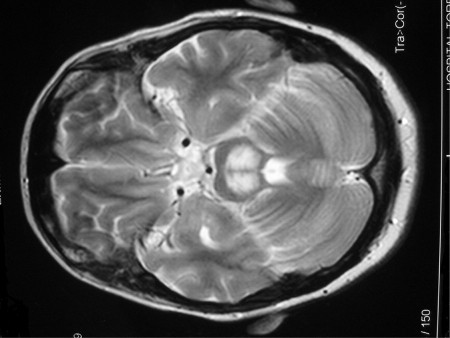Complications
Chronic hyponatremia, if left untreated, can contribute to altered mentation, abnormal gait, osteoporosis, falls, and increased risk of significant fractures. Outpatient maintenance of SIADH-related hyponatremia is of utmost importance to avoid associated increased morbidity and mortality.
Occurs in people with longstanding SIADH who undergo overaggressive treatment of hyponatremia.[35]
The brain adapts slowly to hyponatremia by secretion of intracellular solutes such as sodium and potassium initially, followed by amino acids and myoinositol (organic osmolytes).
Overcorrection of hyponatremia can subject solute-poor cerebral cells to shrinkage and CPM.
CPM is characterized by demyelination of pontine, basal ganglion, and cerebellar regions with resultant neurologic symptoms, including behavior disturbances, lethargy, dysarthria, dysphagia, paraparesis or quadriparesis, and coma.[Figure caption and citation for the preceding image starts]: Pontine demyelination in axial T2 MRI sequencesFrom: P. J. Serrano-Castro, G. Alonso-Verdegay, G. López-Martínez, et al. BMJ Case Reports 2009; doi:10.1136 [Citation ends].
Seizures may also be seen, but are less common.[22]
One case study of patients with hyponatremic encephalopathy, reported in early 2015, included 71 hyponatremic episodes in which patients were treated with aggressive 3% NaCl resuscitation.[36] Twelve of the patients in the study died of comorbid conditions prior to 6-month follow-up. Of those who were re-evaluated, no patient demonstrated neurologic symptoms consistent with cerebral demyelination.
Malnutrition, potassium depletion, and hepatic failure increase the risk of developing CPM.[22][23]
CPM occurs more frequently in longstanding SIADH, due to brain adaptation to hyponatremia. It can also occur in acute SIADH (duration ≤48 hours), but this is less likely.
To treat overcorrection of hyponatremia (either as a result of aggressive salt administration or of spontaneous water diuresis after offending medications are discontinued), free water is replenished through increased oral intake or hypotonic fluids.
Use of this content is subject to our disclaimer